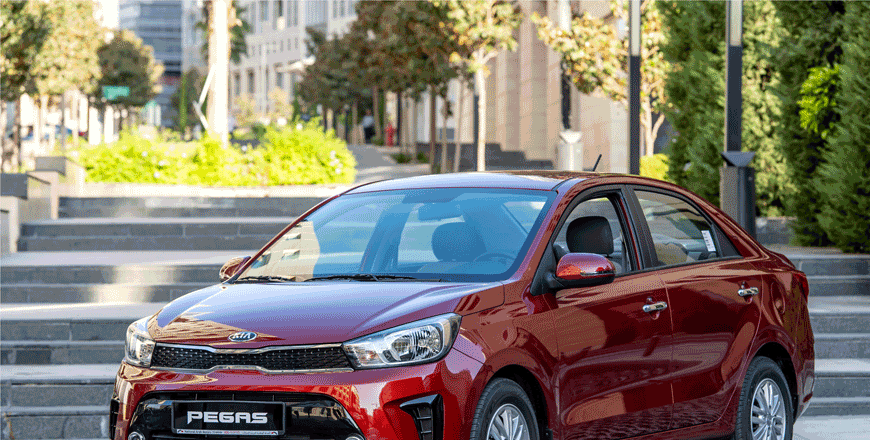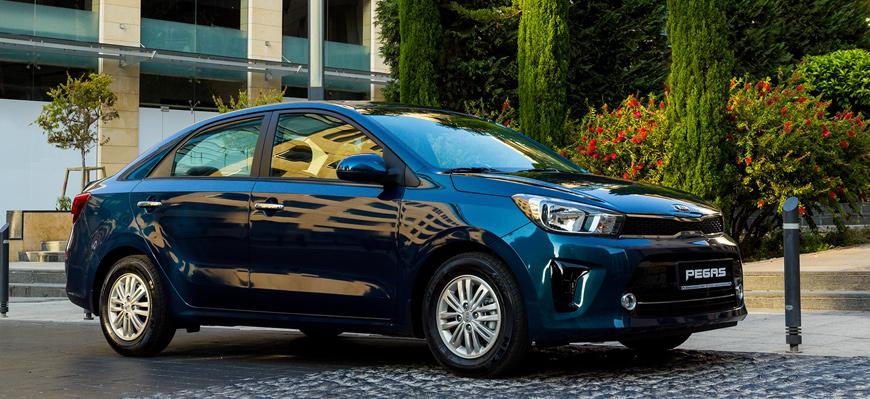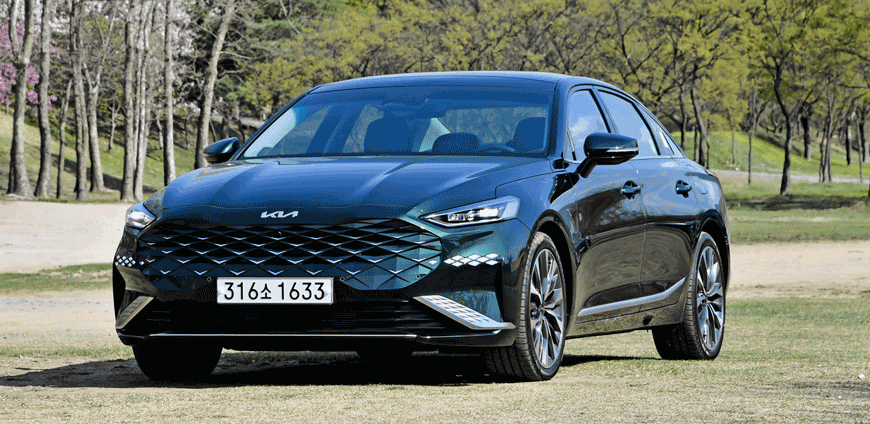You are here
Kia Pegas: A contemporary, cost effective peoples’ car proposition
By Ghaith Madadha - Dec 05,2022 - Last updated at Dec 05,2022

Photo courtesy of Kia
Developed with emerging markets in mind and built in collaboration with Kia’s Chinese Dongfeng partner, the Pegas arrived in the region back in 2018 to support the brand’s entry-level end of the market, as its other offerings slowly but surely inch further upmarket. Based on — and slotting in below — the Rio saloon in an ever-expanding and more sophisticated Kia line-up, the Pegas is instead positioned to take on small affordable “world cars” like the Renault Logan head-on, in the competitively cut-throat small saloon B-segment.
Rationalised and refined
The Pegas was developed to be cost effective and affordable for value-oriented, first-time, family and fleet buyers. It incorporates proven components, Chinese production and a rationalisation of some better features and finishing materials, and well-selected equipment to maximum effect to attract buyers. Designed with a slim version of Kia’s trademark ‘Tiger-nose’ grille, big gaping and functional lower, and faux gill-like side intakes, chiselled bonnet, high waistline and ridged surfacing, the Pegas fits seamlessly into Kia’s contemporary design direction, without being overly dramatic or ambitious in aesthetic.
Even more relevant now than when it first arrived, given the gloomy global financial forecast, the rationalised and economy-oriented Pegas is powered by a sole engine option chosen for efficiency, reliability and cost-effectiveness. The Pegas’ naturally-aspirated 1.4-litre 4-cylinder engine is meanwhile mated to a choice of 5-speed manual or 4-speed automatic gearboxes, driving the front wheels. Producing 94BHP at 6,000rpm and 97lb/ft torque at 4,000rpm, the comparatively lightweight Pegas is good for 180km/h, while 0-100km/h acceleration is estimated at 13.1-seconds. Combined fuel efficiency is meanwhile restrained at 6.1l/100km.
Smooth and progressive
Under-square in design and slightly more torque-biased, the Pegas’ engine nevertheless revs freely, and with a faint, distant, and muted top-end snarl. Smooth and progressive throughout its rev range, the Pegas builds power and torque in a linear fashion and is as responsive at low-end and versatile in mid-range as can be expected of such a modestly powered car. That said, it manages to keep a fair pace at moderate inclines and in city, highway and country road driving.
Driven in auto guise, the Pegas was often hunting for a lower gear and alternately up-shifting when driven at a constant 80-100km/h on mostly inclined routes, so as to maintain or build speed. In such conditions, the Pegas would have benefitted from a fifth gear and closer gear ratios. Alternatively, the manual gearbox version would have provided the necessary ratios, quicker pace, better efficiency and more driver involvement. The Pegas’ 4-speed auto was nevertheless and otherwise smooth shifting, reasonable responsive and economical.
Comfortable
and manoeuvrable
Riding on a Macpherson strut front and torsion beam rear suspension design, the Pegas is smooth riding and reassuringly stable on highway. It is, meanwhile, manoeuvrable, agile and easy to drive in town. A more refined drive than anticipated in its ride quality and noise, vibration and harshness isolation, the Pegas’ light steering may initially seem somewhat vague at low speed. However, pushed somewhat harder through corners, it weighs up with a more communicative level of resistance. Body roll and understeer are meanwhile kept to a minimum.
Comfortable over Jordan’s lumps, bumps and imperfect road surfacing without wallow or much bounce, and seemed settled on rebound after dips and crests. The Pegas gains much of its pliancy from its narrow and tall 175/70R14 tyres, which are sized to be affordable, efficient and more durable in the face of high kerbs and deep sudden ruts and potholes. The Pegas’ tyres meanwhile also promote a more nuanced steering feel for road textures, car position and dynamic limits as it nimbly zips through switchbacks or city streets alike.
Practical and sensible
A narrow car with comparatively good 150mm ground clearance to better cope with poorly paved roads, the Pegas is well suited for busy urban roads and less developed areas. Inside, it has good sightlines and a comfortable driving position with rake-adjustable steering and easy to reach, user-friendly console and layouts. However, it could benefit from slightly lower front seat mounting points for taller drivers, when equipped with a sunroof. Meanwhile, rear seats are adequately spaced for adults, if not as generous as its 475-litre boot volume.
A practical, attainable and manoeuvrable compact saloon with tight city-friendly 10.4-metre turning circle, the Pegas is, meanwhile, rather well-equipped for its segment. The Pegas’ features list includes a 7-inch screen Android Auto-, Apple Carplay- and Bluetooth-enabled infotainment system, rear parking sensors, A/C, electric windows, remote central locking, ABS, ESC and four airbags.
Using some hard plastic textures, the Pegas’ uncluttered dashboard seems more stylishly upmarket than its faux leather or shiny fabric upholstery. Meanwhile, other upmarket features include an integrated driver’s armrest, and intuitively stepped auto gear lever motion.
TECHNICAL SPECIFICATIONS
Engine: 1.4-litre, transverse 4-cylinders
Valve-train: 16-valve, DOHC
Gearbox: 4-speed automatic, front-wheel-drive
Power, BHP (PS) [kW]: 94 (95) [70] @6,000rpm
Specific power: 67.3BHP/litre
Power-to-weight: 90.3BHP/tonne
Torque, lb/ft (Nm): 97 (132) @4,000rpm
Specific torque: 94.5Nm/litre
Torque-to-weight: 126Nm/tonne
0-100km/h: 13.1-seconds
Top speed: 180km/h
Fuel consumption, combined: 6.1-litres/100km
Fuel capacity: 43-litres
Length: 4,300mm
Width: 1,700mm
Height: 1,460mm
Wheelbase: 2,570mm
Overhangs, F/R: 785/945mm
Tread, F/R: 1,509/1,515
Ground clearance: 150mm
Aerodynamic drag co-efficient: 0.29
Headroom, F/R: 995/952mm
Legroom, F/R: 1,062/865mm
Shoulder room, F/R: 1,365/1,357mm
Hip room, F/R: 1,352/1,295mm
Luggage volume, min/max: 475-litres
Kerb weight: 1,041-1,062kg
Steering: Electric-assisted power steering
Turning Circle: 10.4-metres
Suspension: MacPherson struts/torsion beam
Brakes, F/R: Ventilated discs/drums
Tyres: 175/70R14
Related Articles
An attainable everyman’s well-equipped and un-pretentious car designed primarily for developing market drivers, the Kia Pegas launch in rece
A thoroughly better appointed, equipped and designed vehicle than it has ever been since its 2002 introduction, the Kia Sorento has over the
Making it global debut in 2021 and introduced to regional markets in recent weeks as part of a multimodel hybrid electric vehicle launch, th


















